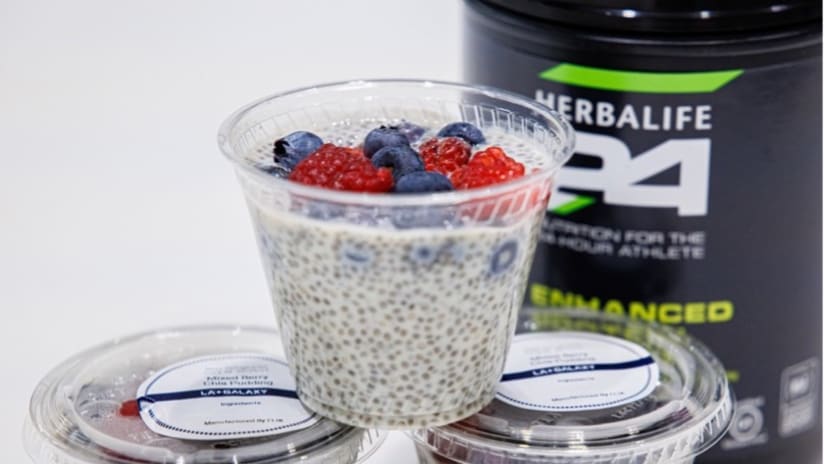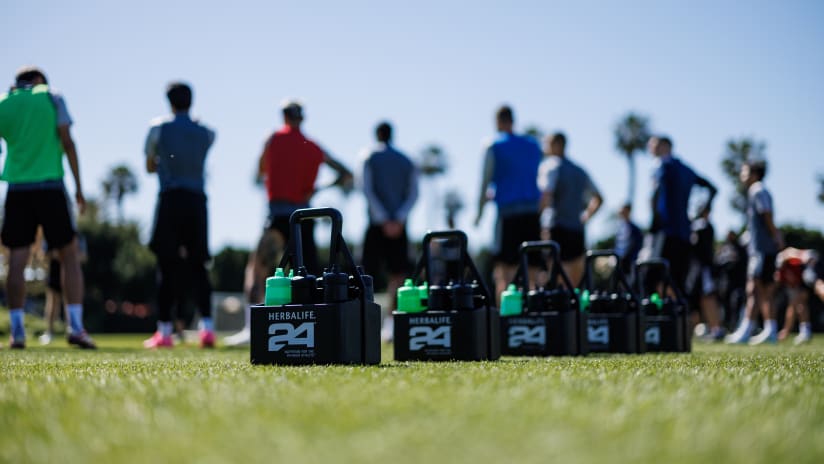Herbalife is the sports nutrition and presenting partner for the LA Galaxy. Herbalife Dietitians work closely with the LA Galaxy technical staff to make sure we are maximizing their nutrition to support performance goals.
One of the most popular (and my personal favorite!) cold bar items available at our Training Table each day at the stadium is Chia Pudding. Read about the potential sports performance benefits of chia seeds and fuel like the Galaxy athletes do by following the simple recipe at the bottom of this article.
What are Chia Seeds?
Chia seeds are the small seeds of the Salvia hispanica plant native to Mexico and Central America.1 The ancient populations in these regions would mix chia seeds in water (referred to as Iskiate) during conquests, and supposedly referred to chia seeds as “the running food.”2,3
Since these tiny seeds have gained popularity in recent years, you are now likely to find chia seeds, which can be white or black, in your local grocery store.
While these seeds can be eaten raw, it is best to soak them in some liquid prior to consumption to facilitate digestion and maximize nutrient absorption.4 When soaked, chia seeds absorb liquid to become up to 12 to 15 times larger.1,5 This results in a gel-like consistency dotted with chewy seeds, similar to tapioca.
Chia Seeds Nutrition
Per 2 tablespoon serving, chia seeds provide:6
· 138 calories
● 5 g protein (complete protein containing all 9 essential amino acids)
● 10 g dietary fiber
● 9 g fat (including 5g of omega-3s)
● 180 mg calcium
● 220 mg potassium
● 2 mg iron
For people who do not consume enough fiber (minimum of 25 g/day for women and 38 g/day for men), it is advised to slowly introduce soaked chia seeds to your daily regimen after training as the high fiber content can cause digestive discomfort if you are not acclimated to it. Most people who consume plenty of fiber each day should not feel digestive distress after consuming chia seeds.
Chia Seed Pudding Performance Benefits
The nutritional profile of chia seeds- including omega-3 fatty acids, protein, fiber, calcium, and antioxidants- may result in quite a few benefits for sports performance and helps to support overall wellness.
Reduced oxidative stress1,5,7
The antioxidant and omega-3 content of chia seeds may help to optimize recovery by fighting oxidative stress throughout the body. Protein is also essential for muscle repair and recovery.
Increased energy and endurance1,2
Chia seeds are rich in oligosaccharides, fiber, and protein, which together serve to regulate blood sugar and provide sustained energy for increased endurance. The iron in chia seeds helps transport oxygen to muscles during activity, which can further increase energy and endurance. Consume chia seeds with a source of vitamin C (i.e., oranges, berries, kiwi, mango, etc.) to enhance iron absorption in the gut.
Hydration1,5
Dehydration is a major cause of poor performance as it negatively impacts concentration and focus, and is also generally detrimental to overall health. Athletes lose a lot of water during training and matches, making hydration a key focus of any sports performance nutrition regimen. After being soaked, chia seeds absorb up to 12-15 times their weight in water. When you consume the soaked seeds, you are also improving your hydration status as you intake water as well.
Improved cognition1,7,8
Omega-3 fatty acids can have a role in maintaining a healthy nervous system. Athletes also often require more daily omega-3s (2-4g) than a typical person. For those with vegetarian diets or seafood allergies, chia seeds are one option to increase omega-3 intake.
Support bone health1,6,7
Chia seeds provide calcium, phosphorus, and magnesium. The body uses these minerals to maintain the skeletal system. With nearly 15% the recommended daily value of calcium in a 2 tbsp portion, chia seeds are a great option for increasing calcium intake in athletes who avoid dairy products.
LA Galaxy Chia Pudding Recipe
Makes 1 serving
Ingredients:
- 1 cup unsweetened vanilla almond milk
- 1 scoop Herbalife24 Enhanced Protein Powder
- 3 tbsp chia seeds
- 2 tsp maple syrup
- ¼ tsp vanilla extract
Method:
- In a medium bowl or jar, mix all ingredients together until the mixture looks mostly uniform.
- Cover and refrigerate for about 8 hours, or until most of the liquid has been absorbed by the chia seeds and it has reached a pudding consistency. Stir well.
- Enjoy!
Enhanced Protein Powder is a dietary supplement. Use only in amounts and frequency stated on the label directions.
Customize Your Chia Pudding
The recipe provided above is a simple Chia Pudding base that you are able to customize according to your personal preferences.
Here is a list of potential customizations to spark inspiration:
- Add orange or lemon zest to chia pudding base and top with orange wedges and berries
- Blend almond milk with berries of choice before mixing with chia seeds for added flavor and color, then top with mixed berries
- Make a parfait by layering with your chia pudding Greek yogurt for extra protein
- Blend almond milk with 2 tbsp cocoa powder and top with sliced bananas and cinnamon
- For a PB&J treat, blend almond milk with some nut butter before adding the chia seeds, then layer with muddled berries or jam of choice
- Swap the almond milk with coconut milk, top with shredded unsweetened coconut and chopped pineapple for a tropical vibe
- Make it Key Lime Pie by adding key lime juice and zest to taste, then top with coconut whipped cream and crumbled graham crackers
References
1. Ullah R, Nadeem M, Khalique A, et al. Nutritional and therapeutic perspectives of Chia (Salvia hispanica L.): a review. J Food Sci Technol. 2016;53(4):1750-1758. doi:10.1007/s13197-015-1967-0
2. Illian TG, Casey JC, Bishop PA. Omega 3 Chia seed loading as a means of carbohydrate loading. J Strength Cond Res. 2011;25(1):61-65. doi:10.1519/JSC.0b013e3181fef85c
3. Scheer, JF. The Magic of Chia: Revival of an Ancient Wonder Food. Berkeley, CA: Frog, Ltd., 2001.
4. Zare T, Rupasinghe TWT, Boughton BA, Roessner U. The changes in the release level of polyunsaturated fatty acids (ω-3 and ω-6) and lipids in the untreated and water-soaked chia seed. Food Res Int. 2019;126:108665. doi:10.1016/j.foodres.2019.108665
5. Kulczyński B, Kobus-Cisowska J, Taczanowski M, Kmiecik D, Gramza-Michałowska A. The Chemical Composition and Nutritional Value of Chia Seeds-Current State of Knowledge. Nutrients. 2019;11(6):1242. Published 2019 May 31. doi:10.3390/nu11061242
6. U.S. Department of Agriculture. Seeds, chia seeds, dried. FoodData Central. April 1, 2019. https://fdc.nal.usda.gov/fdc-app.html#/food-details/170554/nutrients
7. Khalid W, Arshad MS, Aziz A, et al. Chia seeds (Salvia hispanica L.): A therapeutic weapon in metabolic disorders. Food Sci Nutr. 2022;11(1):3-16. Published 2022 Dec 15. doi:10.1002/fsn3.3035
8. Omega-3 Fatty Acids and Performance. Collegiate and Professional Sports Dietitians Association. Accessed August 8, 2023. https://www.sportsrd.org/wp-content/uploads/2020/05/omega-3_Infographic.pdf.





